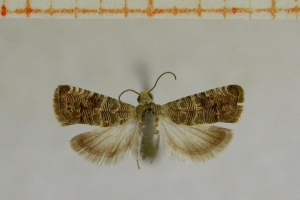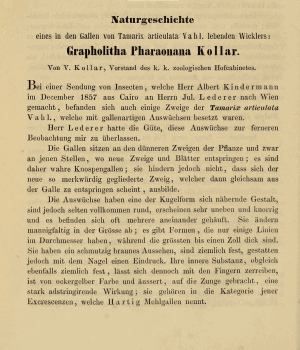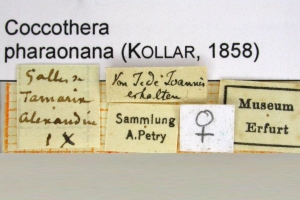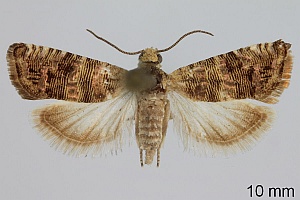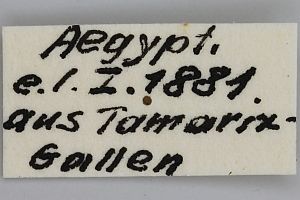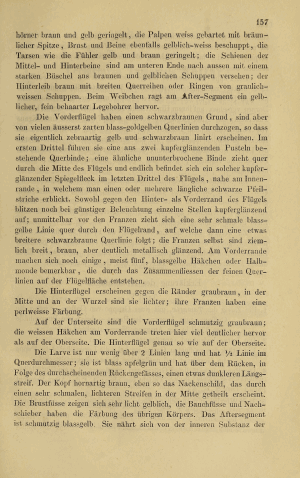

 +17Kontinente:EUASAF
+17Kontinente:EUASAF2. Diagnose
2.1. Weibchen
2.2. Beschreibung als Grapholitha pharaonana
3. Biologie
3.1. Nahrung der Raupe
- [Fabaceae:] Vachellia karroo ? [= Acacia karroo ?] (Akazie ?)
- [Tamaricaceae:] Tamarix ? (Tamariske ?)
Larsen (2023: 52) trägt das - insgesamt doch sehr begrenzte - Wissen zur Biologie der Raupe zusammen: "The species is bred from swollen thorns (domatia) on different acacia trees (Agassiz & Aarvik, 2014; Aarvik, 2019), rather big galls on Tamarix (Kollar, 1858 & Frauenfeld, 1859), galls induced by the host-specific rust fungus Ravenelia macowaniana Pazschke on Acacia karoo Hayne (McGeogh, 1993 & McGeogh & Krüger, 1994) and in shoots and leaves of groundnut plants (Diakonoff, 1968). It is also reported living on the scale-insect Ceroplasta (Meyrick, 1914). The species is bred from galls on different species of Tamarix in Egypt around Cairo and the Sinai Peninsula, described in detail by Kollar (1858) & Frauenfeld (1859). Frauenfeld (1859) has found the species in combination with other gall living insects and he suggested that C. spissana is living in the galls but does not cause the galls. The author has searched the larva intensively several times on Tamarix both in Morocco and the Canary Islands without any success." Wovon sich die Raupe tatsächlich ernährt, wissen wir also nicht.
Larsen (2023: 57) fasst für die drei von ihm besprochenen Arten der Gattung zusammen: "The biology of Coccothera species is an unsolved riddle. Of the three species dealt with here only the biology of C. spissana is known, but only to a certain limit. It seems that the species itself does not produce the galls, but is somehow connected to galls on Tamarix and Acacia. It is not known if the larva lives off sap, parts of the galls or other insects producing the galls or are just living in the galls. The species has also been bred from groundnuts where it lives on shoots and young leaves, which also could be the case when living on the other host plants. The question might be solved by breeding experiments in the laboratory."
(Autor: Erwin Rennwald)
4. Weitere Informationen
4.1. Andere Kombinationen
- Grapholitha spissana Zeller, 1852 [Originalkombination]
- Eudemis spissana (Zeller, 1852)
4.2. Synonyme
- Grapholitha pharaonana Kollar, 1858 [synonymisiert durch Aarvik (2019)]
- Pammene pharaonana (Kollar, 1858)
- Cirriphora pharaonana (Kollar, 1858)
- Coccothera pharaonana (Kollar, 1858) [synonymisiert durch Aarvik (2019)]
- Coccothera victrix (Meyrick, 1918) [synonymisiert durch Aarvik (2019)]
- Coccothera ferrifracta (Diakonoff, 1968) [Synonym nach Larsen (2023)]
4.3. Taxonomie
Nach Aarvik (2019: 328) ist Coccothera pharaonana als Synonym von C. spissana zu betrachten. Konkret ist zu lesen: "Agassiz (2011) reported rearing Coccothera pharaonana (Kollar, 1858) from swollen thorns (domatia) and leaves of four species of acacia trees in Kenya. At Oshoek River Farm in the Western Cape (see above) numerous Coccothera spissana specimens were attracted to light close to acacia trees. Comparison of genitalia illustrations of southern African specimens with material from Kenya showed that thy belong to the same species (Agassiz pers. comm. 2018). Consequently C. pharaonana also becomes a junior synonym of C. spissana. The genitalia of male and female C. pharaonana were figured by e.g. Razowski (1989) , and the illustrations agree with the genitalia of southern African specimens as well as published genitalia figures of C. victrix by Razowsky & Krüger (2007) and Razowski & Trematerra (2008). Coccothera pharaonana was described from specimens bred from galls on Tamarix in Egypt (Kollar 1858)."
Aus https://www.nhm.ac.uk/our-science/data/butmoth/search/GenusDetails.dsml?NUMBER=6414.0 wird klar, dass Obraztsov (1951) Grapholitha pharaonana als Typusart seiner neuen Gattung Cirriphora Obraztsov, 1951 festlegte. Wenn Grapholitha pharaonana aber Synonym zu Coccothera spissana ist, dann gab es keinen Grund, hier eine neue Gattung beschreiben zu wollen. Cirriphora pharaonana ist also Synonym zu Coccothera spissana.
4.4. Faunistik
Nach afromoths.net kommt die Art in Kenia, Mosambik, Saudi-Arabien und Südafrika vor. Locus typicus ist Natal im Osten von Südafrika. Das Synonym Grapholitha pharaonana wurde aus der Umgebung von Kairo in Ägypten beschrieben.
Larsen (2023: 51-53) handelt die Art sehr umfassend ab. Aus europäischer Sicht von besonderer Bedeutung ist der Nachweis eines Männchens auf Fuerteventura (Kanarische Inseln) und damit in Europa i.w.S. Er fasst zur Verbreitung zusammen: "Coccothera spissana (Zell.) is a very widely distributed species living in the dryer part of the African savannah zone. Outside Africa it is found in Yemen, Saudi Arabia (Diakonoff, 1983) and the Canary Islands: Fuerteventura. The species is relatively new to the Canary Islands (Moreno, 2014). Kennel (1921) mentions the species from Bithynien, now northern Turkey and Razowski (1989) mentions the species from Algeria and Turkey, which has not been confirmed. Koçak & Kemal (2017 & 2018) do not list the species from Turkey." Er listet neben dem Tier von Fuerteventura von ihm überprüfte Funde aus fogenden Ländern auf: Südafrika, Namibia, Eswatini, Simbabwe, Tansania, Kenia, Äthiopien, Kamerun, Ghana und Yemen.
(Autoren: Erwin Rennwald & Michel Kettner)
4.5. Literatur
- Aarvik L. (2019): Tortricidae (Tortricoidea). – S. 313–347. In: Mey W. & Krüger M. [eds] (2019): The Lepidoptera fauna of a crater valley in the Great Escarpment of South Africa: The Asante Sana Project. — Esperiana Memoir 8: 1-550.
- Beschreibung als Grapholitha pharaonana: Kollar, V. (1858): Naturgeschichte eines in den Gallen von Tamarix articulata Vahl. lebenden Wicklers: Grapholitha Pharaonana Kollar. — Wiener Entomologische Monatschrift 2: 154-158, pl. 5.
- Larsen, K. (2023): Description of a new species from Africa in genus Coccothera Meyrick, 1914, with additional taxonomic and faunistic information on two other Coccothera species (Lepidoptera: Tortricidae: Grapholitini). — Metamorphosis. Lepidopterists' Society of Africa, 34: 50-58. DOI: https://dx.doi.org/10.4314/met.v34i1.5.
- Erstbeschreibung: Zeller, P.C. (1852): Lepidoptera Microptera, quae J. A. Wahlberg in Caffrorum terra collegit. — Kongliga Svenska Vetenskaps-Akademiens Nye Handlingar (Ser. 3), 40: 1–120. [Digitalisat auf biodiversitylibrary.org]

















